MUSEOLOGY AND RESTORATION THEORY - MOD. 1
- Academic year
- 2021/2022 Syllabus of previous years
- Official course title
- MUSEOLOGIA E TEORIA DEL RESTAURO - MOD. 1
- Course code
- CT0605 (AF:340954 AR:181571)
- Teaching language
- Italian
- Modality
- On campus classes
- ECTS credits
- 6 out of 12 of MUSEOLOGY AND RESTORATION THEORY
- Degree level
- Bachelor's Degree Programme
- Academic Discipline
- L-ART/04
- Period
- 2nd Semester
- Course year
- 2
- Moodle
- Go to Moodle page
Contribution of the course to the overall degree programme goals
The primary objective of the course is to make students able to understand the current structure of a museum, its origin and its transformations over time and to realize the cultural intentions of the choices made in its organization and set-up.
The notions learned will allow students to acquire greater awareness in considering a work of art in its change of status over the centuries, in its relationship with other objects belonging to the same collection, in its physical relationship with the public.
Expected learning outcomes
- ability to apply knowledge and understanding: to use specific vocabulary and find textual and iconographic sources useful for reconstructing the history of a museum or collection;
- ability to judge: to discern between the function of an object in common use and the function of the same object after its museum display; to know how to analyze the history of a museum, placing it in the cultural context of the time and in the broader history of museums, to know how to reason on issues related to the conservation, display, handling of works of art;
- communication skills: to know how to use adequate and specific terminology, introduced and explained in lectures or in the reference texts; to learn how to deal respectfully and profitably with teachers and colleagues around the topics of the course;
- learning skills: based on bibliographic and study material, knowing how to analyze the characteristics of a museum, placing them in history and interpreting the cultural reasons for the exhibition choices, placing them in the right geographical context and chronological reference.
Pre-requirements
Contents
The lessons will start by addressing the specific lexicon of the discipline, and then retrace the history that leads from collecting in humanistic studies to the museum of the twentieth century through emblematic cases, observed in their own cultural, chronological and socio-political context and considering in parallel the evolution of the rules related to conservation. Museography themes will also be addressed, in particular with regard to the evolution of educational aids from nineteenth-century tags to 21st-century digital apps. In the second part of the course, the current debate on the role of the museum in post-modern society, on the relationship between history and museum systems, on the movement of works of art for exhibitions, on the use of deposits will also find space.
Referral texts
- Maria Teresa Fiorio, "Il museo nella storia. Dallo studiolo alla raccolta pubblica", Mondadori, Milano 2011 (o edizioni successive)
- Krzysztof Pomian, "Dalle sacre reliquie all’arte moderna. Venezia-Chicago XIII-XX secolo", Il Saggiatore, Milano 2004 (Introduzione e saggio "Collezioni pubbliche e collezioni private a Venezia XIII-XVIII sec.").
- Orietta Rossi Pinelli, "Per una "storia dell’arte parlante". Dal Museo Capitolino (1734) al Pio-Clementino (1771-91) e alcune mutazioni nella storiografia artistica", in «Ricerche di Storia dell’arte», 84, 2004 (2005), pp. 5-23.
Additional bibliography for non-attending students:
- Adalgisa Lugli, "Museologia", Jaca Book, Milano 1992
- Alessandra Mottola Molfino, "Il libro dei musei", Umberto Allemandi & C., Torino 1992, pp. 129-146.
All students, attending or not, are required to visit at least two museums of their choice (to be agreed with the teacher). During the exam they will have to demonstrate that they know the main historical events about these museums and be able to describe the museological criteria and set up bringing specific examples relating to the works on display. Further instructions will be given on this pointduring the lessons. Non-attending students can have clarifications by contacting the teacher in person or via e-mail.
Assessment methods
The exam aims to verify that the knowledge derived from the topics covered during the course has been acquired and the basic concepts of the teaching materials present in the university's moodle platform have been acquired.
Type of exam
Teaching methods
If the restrictions relating to the health emergency allow it, some lessons will be held inside the museums.
